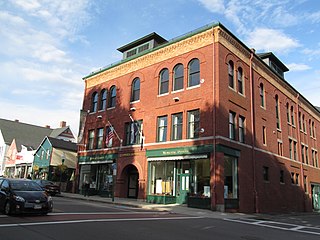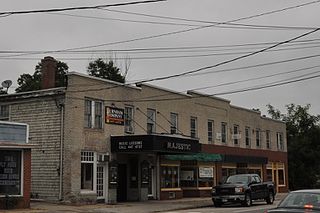
The Michigan Theatre at 124 North Mechanic Street in Jackson, Michigan opened in 1930 and was designed by Maurice Herman Finkel. It was listed on the National Register of Historic Places on May 8, 1980, and is undergoing renovations as of 2005.

The Oregon Commercial Historic District is a historic district in Oregon, Illinois, that has been listed on the National Register of Historic Places since 2006. The district is roughly bordered by Jefferson, Franklin, 5th and 3rd Streets in Oregon. It is one of six Oregon sites listed on the National Register and one of three to be so listed since the turn of the 21st century. The other two are the Oregon Public Library, listed in 2003, and the Chana School, listed in 2005.

The Chamber of Commerce Building is a commercial building on 65 Liberty Street, between Liberty Place and Broadway, in the Financial District of Manhattan in New York City. Designed by architect James Barnes Baker, the four-story Beaux-Arts building was constructed between 1901 and 1902 as the first headquarters to be built specifically for the Chamber of Commerce of the State of New York.

55 Wall Street, formerly known as the National City Bank Building, is an eight-story building on Wall Street between William and Hanover streets in the Financial District of Lower Manhattan in New York City, United States. The lowest three stories were completed in either 1841 or 1842 as the four-story Merchants' Exchange and designed by Isaiah Rogers in the Greek Revival style. Between 1907 and 1910, McKim, Mead & White removed the original fourth story and added five floors to create the present building. The facade and part of the interior are New York City designated landmarks, and the building is a National Historic Landmark listed on the National Register of Historic Places (NRHP). The building is also a contributing property to the Wall Street Historic District, listed on the NRHP.

The P.J. Barrett Block is a historic block in Adams, Massachusetts. It is one of the four brick buildings on Park Street along with the Jones Block, Armory Block, and the Mausert Block, opposite the Town Hall. The block was built in roughly 1880, during a period of rapid industrial expansion in Adams. The original uses of the building were to provide retail shops on the ground floor and apartment-style housing above, a common feature of buildings of the period. It has a somewhat utilitarian appearance, which may be reflective of the relative haste in which it was designed and built. The building has a brick face, and the windows on the upper floors have curved pediments. The building was listed on the National Register of Historic Places in 1982.

The Greenwich Avenue Historic District is a historic district representing the commercial and civic historical development of the downtown area of the town of Greenwich, Connecticut. The district was listed on the National Register of Historic Places on August 31, 1989. Included in the district is the Greenwich Municipal Center Historic District, which was listed on the National Register the year before for the classical revival style municipal buildings in the core of Downtown. Most of the commercial buildings in the district fall into three broad styles, reflecting the period in which they were built: Italianate, Georgian Revival, and Commercial style. The district is linear and runs north–south along the entire length of Greenwich Avenue, the main thoroughfare of Downtown Greenwich, between U.S. Route 1 and the New Haven Line railroad tracks.

Valparaiso has retained an active downtown. It remains a mix of government, retail and business center, with a mixed residential and service area. Numerous economic changes have not changed the basic character, historic courthouse area. The historic district retains the distinctive turn-of-the-19th-century architecture, supporting numerous small specialty shops, shaded sidewalks, and a people friendly environment. The Downtown District, is anchored on the Porter County Courthouse. It includes 14-blocks surrounding the square, bounded on the north by Jefferson Street, on the east by Morgan Street, on the south by Monroe Street, and on the west by Napoleon Street.

The Mississippi Lofts and Adler Theatre is an apartment building and theater complex located in downtown Davenport, Iowa, United States. It is individually listed on the National Register of Historic Places by its original name, the Hotel Mississippi and RKO Orpheum Theater. The Hotel Mississippi was listed on the Davenport Register of Historic Properties in 2005. In 2020 the complex was included as a contributing property in the Davenport Downtown Commercial Historic District.

Gay Street is a street in Knoxville, Tennessee, United States, that traverses the heart of the city's downtown area. Since its development in the 1790s, Gay Street has served as the city's principal financial and commercial thoroughfare, and has played a primary role in the city's historical and cultural development. The street contains Knoxville's largest office buildings and oldest commercial structures. Several buildings on Gay Street have been listed on the National Register of Historic Places.

The Barber Block is a building complex located at the corner of Southeast Grand and Washington Streets in Portland, Oregon, listed on the National Register of Historic Places (NRHP). It was built in 1890 and listed on the NRHP in 1977. It is also located within the East Portland Grand Avenue Historic District.

The Mahaiwe Block is a commercial and theater building in the heart of downtown Great Barrington, Massachusetts. In addition to smaller businesses, it houses the Mahaiwe Performing Arts Center, the town's only major performance space. It has been in virtually continuous operation since its construction in 1905. The building is located at 6-14 Castle St. and 314-322 Main St, and is listed on the National Register of Historic Places.

The Alma Downtown Historic District is a commercial historic district in Alma, Michigan, roughly located along Superior Street between the Pine River and Prospect Avenue, and along State Street between Center and Downie Streets. Parts of the district were designated a Michigan State Historic Site in 1975, and the entirety was listed on the National Register of Historic Places in 2013. It contains 72 structures, primarily brick commercial buildings, ranging from one to three stories in height and dating from 1874 to the 1960s.

The Harrington-Smith Block, formerly known as the Strand Theater and the Manchester Opera House, is a historic commercial building at 18-25 Hanover Street in the heart of Manchester, New Hampshire. Built in 1881 to a design by John T. Fanning for two prominent local developers, the building is an expansive rendition of Queen Anne styling in brick and stone. It housed the city's premier performance venue for many years, and was an early home of the influential Manchester Union Leader, the state's major daily newspaper. The building was listed on the National Register of Historic Places in 1987.

The Cole Block is a historic commercial building at 19 Main Street in Bethel, Maine. Built in 1891, the four story frame structure is the most prominent commercial building in the town. It was listed on the National Register of Historic Places in 1998.

The Camden Opera House Block is a historic multifunction building at 29 Elm Street in the center of Camden, Maine, United States. Built in 1893 after the town's great 1892 fire, it is one of its most prominent buildings. It houses town offices, a social meeting hall, and a 500-seat theater. The building was listed on the National Register of Historic Places in 1986.
The Big Muddy oil field is an oil field in Converse County, Wyoming, between Casper and Glenrock.

The Hotel Higgins, Tabor Hotel or Higgins Hotel was built in 1916-1917 during the oil boom in Glenrock, Wyoming. It was built for John E. Higgins, who was a local rancher, legislator and oil business investor, and his wife Josephine Amoretti Higgins. It was designed by architect Edward Reavill, and it opened on May 9, 1917. After the accidental death of Josephine in 1924 and the death of John in 1926 the property was disputed by their heirs. This was resolved in 1942 when the hotel was sold to Dr. and Mrs. Leonard Tabor at a tax sale, and the hotel became the Tabor Hotel. After several new owners the hotel became the Hotel Higgins again in 1978.

The Mount Pleasant Downtown Historic District is a commercial historic district roughly bounded by Mosher, Franklin, Illinois and Washington Streets in Mount Pleasant, Michigan. It was listed on the National Register of Historic Places in 2014.

The Bolduc Block, also known as the Majestic Theater, is a historic commercial and theatrical building at 36 Main Street in Conway, New Hampshire. Built in 1923, it was the community's first theater. It is also a good local example of Art Deco architecture, a style uncommon in northern New Hampshire, fire damage to its interior. The building was listed on the National Register of Historic Places in 2016, and the New Hampshire State Register of Historic Places in 2015. It is presently owned by the Mountain Top Music Center.

The Howell Downtown Historic District is a primarily commercial historic district located along five blocks of Grand River Avenue in the center of Howell, Michigan. It was listed on the National Register of Historic Places in 1987.





















